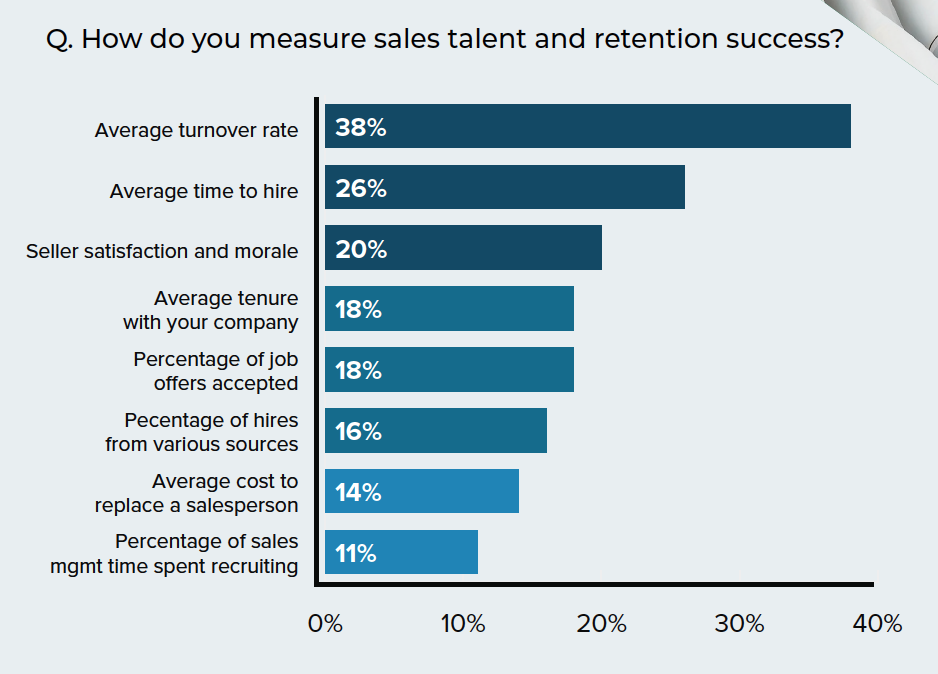Sales talent is the beginning of the sales enablement pipeline. Just as the sales organization must pay close attention to customer acquisition and retention metrics to avoid churn, sales enablement must prioritize sales talent acquisition and retention.
Often, one of the largest operational costs for a sales organization is hiring and onboarding sales talent. These costs increase exponentially with employee churn. In fact, the Sales Enablement Analytics 2019 report found that it costs companies an average of $150,000 to replace a salesperson.
Compounded with the fact that the labor market is growing tighter and it is more competitive to acquire top talent, it is increasingly important for companies to focus on both bringing the right employees on board and incentivizing them to stay. This has resulted in a rising trend in sales enablement to understand how culture — from hiring to retaining the right sales talent — impacts sales proficiency, productivity, and performance.
Hiring and retaining good sales talent can help offset onboarding costs, improve sales culture and morale, and improve an organization’s ability to continue to attract top talent. But despite the overwhelming benefits, the Sales Enablement Analytics 2019 report found that few sales enablement practitioners measure culture-based KPIs yet. Average turnover rate is the most common metric in this category, tracked by just 38%.

Sales enablement needs to begin looking more closely at metrics rooted in culture and holding themselves accountable to the retention of good salespeople. In doing so, sales enablement can increase business impact, as organizations that track proficiency metrics such as seller competency report win rates that are six percentage points higher than those that do not.

“It’s incumbent upon us to make sure that we are looking at the retention of our salespeople,” said Laura Welch, director of sales enablement at HP. “It’s just as important as looking at how are we measuring our programs and all that other stuff that we have to look at to be successful. Are our salespeople happy?”
Here are three ways that sales enablement professionals can begin to prioritize sales talent acquisition and retention to build a healthy sales culture and ultimately increase its business impact.
Build a strong partnership with human resources
At first glance, any metrics related to sales talent acquisition and retention might seem like they belong as an HR responsibility. In fact, ownership of such metrics was a passionate topic among sales enablement practitioners interviewed for the Sales Enablement Analytics 2019 report. Participants emphasized that while the metrics themselves are (or should be) tracked by human resources, the onus of impacting those metrics is a sales enablement responsibility at its core. Thus, sales enablement must develop a close partnership with HR to measure culture-based KPIs.
“A big way we position the value of enablement is increasing employee lifetime value,” said Whitney Sieck, director of enablement at Greenhouse. “In that, we partner with the people team.”
For example, one way sales enablement can partner with HR is in profiling the core competencies required for any new sales hire. When sales reps possess the right proficiencies upon arrival, it will accelerate their time to productivity. Therefore, practitioners can help ensure the teams responsible for hiring know what qualities to look for specific to each role.
In addition to the talent and retention metrics in the graph above, consider tracking things like internal promotions, performance of promoted employees, employee referrals, and tenure. Sales enablement practitioners can build a strong partnership with the human resources team to ensure this data is tracked consistently and apply it to sales proficiency metrics.
Create competency maps and growth plans by role
Impacting the sales culture does not stop at bringing the right people in the door. Sales enablement also has an opportunity to impact retention by incentivizing sales talent through dedicated investment in their learning and career development.
“We all battle this myth that salespeople are coin-operated organisms,” said Leff Bonney, vice president of research and product innovation at Vantage Point Performance and associate professor at Florida State University. “Salespeople are also looking for career opportunities, development opportunities. Is this going to be a challenging job for me?”
No two sales roles are created equal. In any sales organization, there are different markets, territories, personas, and profiles. With so much variability, sales is by no means an easy job. It is vital that each salesperson truly believes that they are in the right role for them. By developing role-specific competency maps and learning paths, sales enablement professionals can help salespeople feel equipped to execute the specific responsibilities of their job.
Included as part of the role-specific competency maps should be growth plans to show salespeople exactly what it takes to move to the next level in their careers.
“If I can get people excited about their possibility in this organization, they’re going to get excited about all this other cool stuff we’re doing, like badging and role-playing,” said Devon McDermott, vice president of global enablement at CM Group. “It’s important to think about it holistically. These are human beings and they want to be treated as such, and they want predictability and success.”
Invest in sales manager enablement and coaching
It is often said that people don’t quit jobs, they quit managers. People want managers that support them, encourage them, and help develop their skills to make them more successful. That’s why frontline managers are so crucial to retaining top talent, as positive coaching and management helps create a healthy, supportive sales culture.
By investing in frontline sales managers and giving them the skills to better support their teams, sales enablement can improve employee satisfaction and thus retention.
“Salespeople want to feel like you’re investing in their coaching, training, and wellbeing, and that you’ve matched them with the right manager, or you’re attempting to do that,” said Welch. “As sales enablement leaders, we have a huge impact on that part, and we can work with their managers and enable their managers.”
To help enable sales managers, work with them to develop basic management skills, create formal coaching frameworks to help them have quality conversations with their teams, and enlist their support in deploying sales enablement activities with their teams.
For sales enablement to ascend to a more strategic function, understanding how culture and sales proficiency intersect is key. To begin prioritizing sales talent acquisition and retention, HR must become a core cross-functional partner of sales enablement. Practitioners also must spend time understanding the competencies needed for each specific role, and design competency maps with a vision for growth. Finally, with a dedication to frontline manager enablement, sales enablement can help ensure salespeople receive the support they need to be successful. In doing so, sales enablement can encourage top sales talent to stay, attract new talent, and forge a healthy sales culture.






